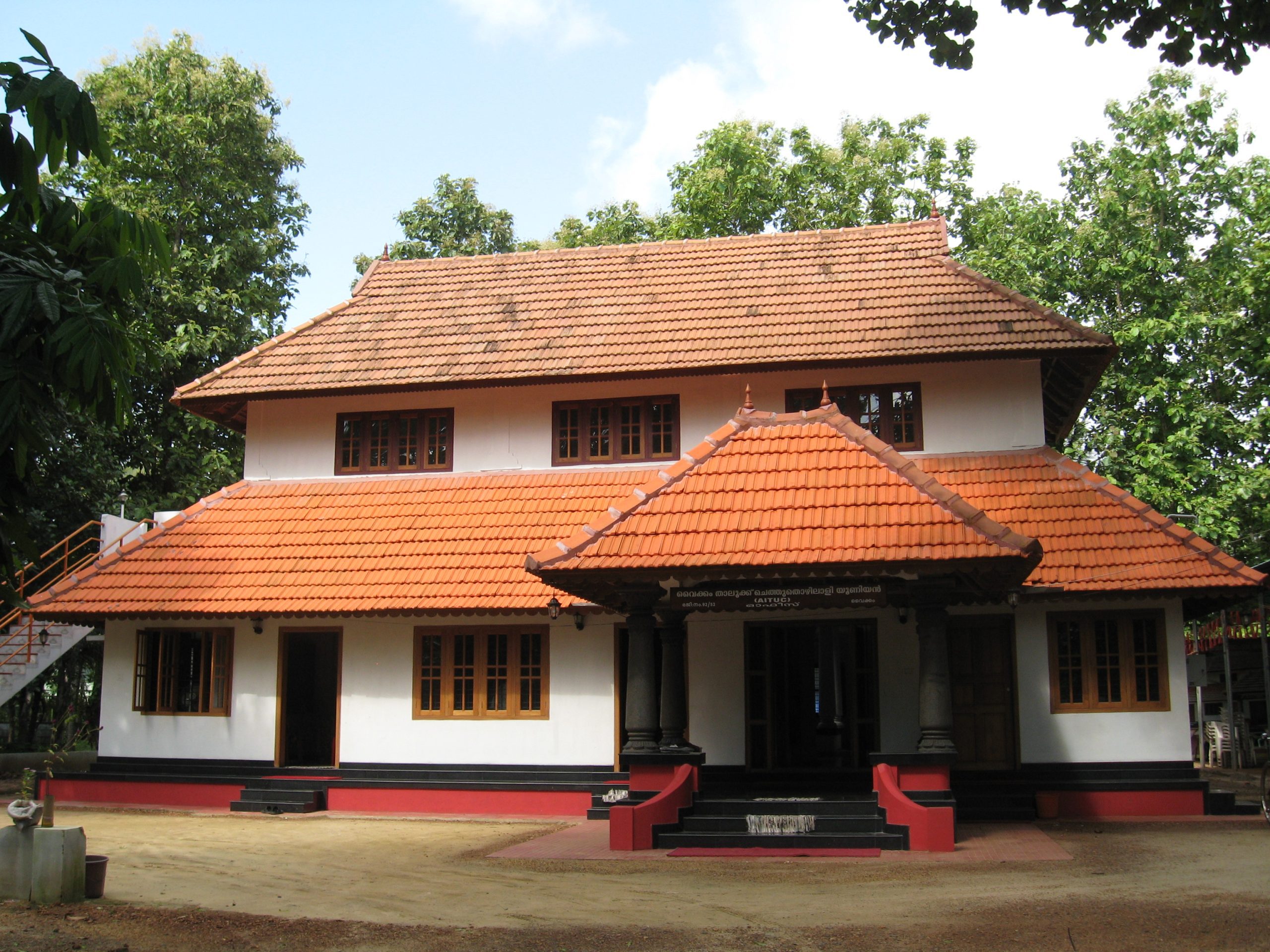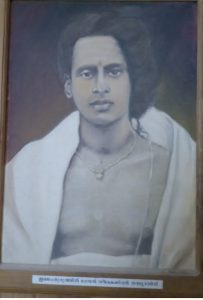Purity-obsessed Indenthuruthi Mana denied Gandhi entry when he arrived to support the Vaikom Satyagraha in 1925.

Indenthuruthi Mana of Vaikom in Kerala which insulted Mahatma Gandhi in 1925 by denying entry citing his lower caste status, is now a union office of toddy tappers. (Creative Commons)
It is nothing but a freakish twist of fate that a mansion owned by purity-obsessed Brahmins, that once denied entry to Mahatma Gandhi because of his caste, is today the office of a Communist-backed union of predominantly lower-caste toddy tappers.
But that is not the reason the imposing, steeped-in-tradition Indenthuruthi Mana, which was home to the haughty trustee of the famous Shiva temple in central Kerala’s Vaikom town, is back in the news.
It is because of a rather unusual demand put forward by the state unit of the BJP.
The party wants the state government to liberate the recently-renovated mansion, situated opposite the Shiva temple in the heart of Vaikom, from its present occupants, the toddy tappers, and declare it a Gandhi memorial.
It’s a demand that has raised the hackles of the toddy tappers and some sections of civil society. Read on to find out why.
The year was 1925, the month March. Vaikom, then part of the erstwhile Travancore state, was in the grip of an unprecedented and ongoing agitation that had already lasted a year.

A portrait of Devan Neelakandan Namboodiri, which adorns the walls of the Vaikom Satyagraha Museum in Vaikom. (Supplied)
The Vaikom Satyagraha had been launched the previous March to force the famous Shiva temple in the town to allow the entry of Dalits and other lower-caste individuals. Not only were they not allowed to enter, but they were also banned from walking on the roads surrounding the temple.
The non-violent agitation — one of the most significant social-reform protests in the country — captured national attention due to police repression and the targeting of activists, mostly from the Congress, by the upper castes.
Several national leaders, including Mahatma Gandhi, soon arrived in town to support the agitation.
On his arrival in Vaikom, Gandhi, as was his wont, sought a dialogue with Devan Neelakandan Namboodiri, the then chief trustee of the temple and head of the Indenthuruthi Mana, a two-storey structure complete with the traditional inner courtyard and wooden granaries of Brahmin residences.
Responding to the invitation, the Namboodiri said custom did not permit him to go out to meet people, and asked Gandhi to meet him at his house. The Mahatma ignored the slight and reached the Mana along with stalwarts of the national movement, like C Rajagopalachari, Mahadev Desai, Ramdas Gandhi, and TR Krishnaswamy Iyer.
The Namboodiri said a pandal had been erected outside for Gandhi and his team because allowing a Vaishya like him to enter the house would defile it.
In the subsequent interaction, Namboodiri and other upper-caste Hindus stayed inside the house to avoid eye contact with those of a lower caste.
Gandhi failed in his mission of persuading Namboodiri, as the chief trustee would not entertain the idea of allowing the lower castes — so born, according to him, because of their karma — anywhere close to the temple.
Neelakandan Namboodiri stubbornly refused to consider any of the suggestions made by Gandhi. He said the customs his community followed had the sanction of Adi Sankara. And once a disappointed Gandhi left, he ordered a ritual cleansing of the premises.
Mahadev Desai, who accompanied Gandhi for his meeting with Neelakandan Namboodiri, documented the conversation between the two.
To Gandhi’s question on why the savarnas of Travancore treated the low castes so harshly, the Namboodiri said lower-caste Ezhavas and Pulayas in the state were reaping their karma. He said their bad behaviour in a past life had relegated them to the bottom of the pile in this one.
Gandhi told the Namboodiri that his response was both brutal and shocking.
“When Gandhi visited Vaikom, the Mana and its head Namboodiri were shining icons of arrogant orthodoxy that prevailed in the then princely state of Travancore. It was, in fact, worse than what a ticket examiner of the South African railway did to Gandhi earlier by forcibly deboarding him from the first class of a Durban-Pretoria train,” noted thinker Sunil P Ilayidam told South First.
“In South Africa, he was not a known figure. But by the time of the Vaikom Satyagraha, Gandhi had evolved into a much-revered national leader,” added Ilayidam, who uses his speeches to stress how history avenged the humiliation suffered by Gandhi at the Mana by turning the mansion into a toddy tappers’ union office.
“The BJP wants to turn a standing testimony of unpardonable discourtesy to Gandhi by caste Hindus into a memorial to him? What’s the logic behind it? Gandhi was not allowed inside, and he left the premises with a heavy heart after the failure of the talks,” said Ilayidom.
According to former Kerala minister and senior CPI leader Mullakkara Ratnakaran, the toddy tappers’ union bought the building and the land housing it in 1963s by paying ₹1.5 lakh to the descendants of the Namboodiri, who by then were facing a severe financial crisis.
The joint Namboodiri family had to sell the mansion to raise money for the marriage of a woman member.
Changes in land-use patterns, depletion in agricultural income, the state taking away surplus land under its much-celebrated land-reform initiative, and the loss of control over the temple administration had landed the family in dire straights.
In 2009, the toddy tappers pulled down the dilapidated old structure and constructed a new building to the same specifications, thus retaining its old-world charm and architectural peculiarities.
Inside the building, the toddy tappers keep a portrait of Gandhi adorned with red garlands.
However, the BJP now wants more respect for the Father of the Nation.
At a recent public meeting, BJP state president K Surendran wondered why the state government was not declaring it a memorial to the Gandhian legacy.
He also suggested there was something wrong in the manner the toddy tappers had “usurped” the ownership of the “historical building” of “national importance”.
Surendran’s suggestion has met with stiff resistance not only from the toddy tappers’ union that currently occupies the building, but also from civil society, with some failing to understand the logic of converting a place where Gandhi was “insulted” into a memorial to him.
“Surendran has to learn history properly before making such strange claims. Our comrades bought an old building, set aside for public sale, by paying the prevailing market rate. There is no mystery in the transfer of the building to the trade union of the CPI,” the party’s state assistant secretary K Prakash Babu told South First.
“Of course, there was politics behind the purchase, as the workers wanted to avenge the humiliation of Gandhi in their own way,” he added.
Opposition leader VD Satheesan told South First that the state had enough Gandhi memorials, and that it didn’t require another — especially one where the Father of the Nation was humiliated and not allowed to enter.
Malayalam writer S Saradakutty termed the new controversy sparked by Surendran as a reflection of the BJP’s continuing mistreatment of people from the lower castes.
“It may be uncomfortable to the BJP to see that lower-caste toddy tappers have taken over a feudal relic that has the dubious legacy of insulting the Father of the Nation,” Saradakutty told South First.

Apr 26, 2024

Apr 26, 2024

Apr 25, 2024

Apr 25, 2024

Apr 25, 2024

Apr 25, 2024